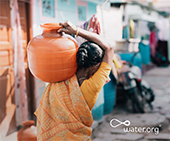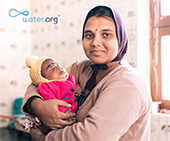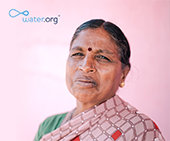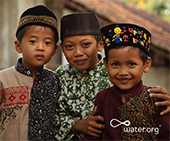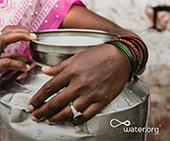Imagine if you had to walk miles for a glass of water. This is the reality for millions of women and children. Collectively, women and children spend 125 million hours every day walking and collecting water for domestic use. When women and children gain access to water they are healthier and have more time for education, work and raising their families.
I know there are a lot of worthy charities out there. I’ve created my own fundraiser for Water.org because I believe safe water is necessary for life. The water crisis is something I feel I can help solve. I hope you agree by giving whatever amount you can to support my efforts.
For every $25 that I raise, Water.org can give someone access to safe water for life. Co-founded by Matt Damon and Gary White, Water.org has been helping people develop sustainable solutions for more than 25 years. Together, we can change lives with safe water.
We are working with tribal people of visakha agency, Gudem. Our organisation name is Girijana Seema Welfare Association, registered in 1977, under 1350 fasli act Andhra Pradesh, India.
We have constructed rain water harvesting tanks also with the support of Barefoot College.
Most of our tribal villages do not have drinking water supply. People are depending up on the streams & springs.
1. Project Location and Description: The Visakha District Agency area falls under crucial geopolitical area of Eastern Ghats. The District is a major district of Andhra Pradesh. There are Eleven Mandals in agency area which is called a revenue division with Head Quarters at Paderu. The area is on average 3000 feet above sea level is a summer resort in the State.
This is hilly terrain is bestowed with dense forest growth. The area is designated as nontraditional coffee growing area and coffee is widely grown both by the Forest Department and tribal farmers.
2.Problem Description:
In spite of having good rains through the year, the people of visakha agency people are facing drinking water problem. They do not have proper water supply system.
Ground water level of this area is in between 200 – 250 ft. there is no proper water storage or collecting facilities in this area. Open wells and hand pumps are also very less in number compare to the planes.
Tribal people of this area reside on the hills and they do the podu agriculture. Main water sources of this area are springs and canals.
Usually people resides at mid- point of the hills. Water sources (springs) are located at either top or bottom of that hill. Tribal women and children are spending their most of the time and energy to bring water from the sources (top or bottom of the hill). Children are becoming drip outs due to this. In the rainy season they are fell down and injured while bringing the water from the sources due to difficult path.
They are unable to bring enough water for their daily usage. It in turn leads to poor hygienic condition and its related diseases. Due lack of proper hygienic management at the water source, water borne diseases are also most common in our areas.
3. Socio-economic Setup
Most of the community of village is poor and job opportunities are negligible. A small portion of the population (30%) has income in the range of Rs. 6000 or above while the remaining (70%) population has income below Rs. 3000 per month. Majority of the population are involved in farming and agriculture and unskilled workers who work on daily wage basis in the area. Some people are doing jobs in govt. organizations. Majority of the youth are jobless.
4. Project Identification
GSWA is implementing Rain Water Harvesting project in funded by Barefoot College.
GSWA has established project committees (Water Management Committees – WMC) at different villages of Gudem and Chintapalle tehsils and has close liaison with these Committees. Members of these Committees of the villages have requested GSWA for the provision of Drinking Water services.
Field team of GSWA conducted social and technical survey of the villages and found that there are currently no existing drinking water systems.
GSWA staff found the area suitable for the implementation of Drinking water supply scheme (Gravity or Zero “0” Energy Pumps). They found that the most alerting problem of the area either water source is available at the top of the hills or the bottom of the hill where as villages are located at middle of the hills.
The project is designed keeping in view urgent need of the community and their willingness to shoulder responsibility to implement this project. After conducting socio-economic survey and technical feasibility of area, Field Engineer and Social Organizers suggested Gravity pipes or Zero “0” Energy Pump installation to supply the water.
This will address the water supply problem of the area to a great extent.
5. Proposed Project Objectives
Project Objective-1
To empower the local village community to implement and undertake their own water supply programme by forming a village committee.
Activities Planned Under PO-1
1. Meeting with the Village Community for:
1.1. Signing Memorandum of Understanding (MoU) between GSWA and village Committee on roles and responsibilities.
1.2. Formation of Committees (Project Committee, Operation and Maintenance Committee)
1.3. Setting out operation and maintenance plan
1.4. Setting out implementation strategy and plan for various activities of the project
2. Documentation of outcomes of meeting
3. Community Motivation and Social Organization (During Implementation of project)
4. Village level mass meeting before implementation
5. Weekly visits of the Social Organizers/engineer to the project area
6. Weekly meetings with the committees
Project Objective-2
To provide clean drinking water facilities to the people of the village and enable them to mobilize their resources for their own betterment
Project Activities under Objective 2:
• The GSWA Technical team along with the Village Committee will undertake a survey for the selection of suitable sites for installation of Gravity pumps Or Zero “0” Energy Pumps
• Water user committees will be formed for each Gravity pumps or Zero “0” Energy Pumps.
• The Village Committee will start to mobilize sufficient funds for their input as maintenance of the system.
• The required diameter pipes for the water supply from the springs which are located at the top of the hills or the sizes of the valves for the Zero “0” Energy Pumps which can supply water from the springs, located at the bottom of the hill will be identified and purchased from the market.
• Construction of storage tank and fixing the pipes from the water source will be done under strict supervision of Field Engineer and Project Committee.
• Copies/prints of the design will be given to Village Committee for guidance.
• Work Completion certificate from Village Committee.
• Formulation of complete list of beneficiaries
6. Social Organization
Development is a process of social, economic and technical change that provides the opportunity for economic betterment, greater human dignity, security, justice and equity.
The main goal of this project is to raise the spirit of self-help, self-reliance and self management among the community of proposed village so that they are enabled to participate as actors in the development process rather than as passive objectives of development.
GSWA has already formed a representative Community Organization (CO) in the proposed village in shape of with the help of community. GSWA believes that promotion and strengthening of representative, transparent and accountable local level institutions is an effective way of resource mobilization at community level, which meets the needs of all community members. Throughout project life they said CO will be empowered and strengthened so that they can implement all project activities themselves. GSWA will only facilitate the CO in implementation of the project.
Introduction of concept and methodology of project to the community members is an important project step. Social Organizers of GSWA will hold meetings with the well known/influential community members of the project area to gain their full support to ensure complete success of the project.
GSWA field staff (Social Organizers) will also hold regular meetings with the community groups and individuals at GSWA Sub Office. In these meetings they will be told about importance and need of Social Organization (CO) for the development of village.
This will cultivate friends and support for the CO among the community. Regular meetings with the CO will help the CO members to understand the organizational behavior. They will understand their roles, responsibilities and duties within the organization. Sense of ownership among the members will be created and they will prefer common interest to individual interests. Social Organizers of GSWA will help CO in building strong linkages and co-ordination with other organizations. They will also help CO in identification of productive activities and establishment of priorities.
Project Committees often dissolve after completion of the schemes. Therefore, Community Based Organizations will be strengthened for undertaking further village development.
.
7. DESIGN
Design of the project
Water sources are located at either top of the hill or bottom of the hill.
Gravity pump can be used to supply the water from the water source which is located at top of the hill.
Zero “0” Energy Pump can be used to supply the water from the water source which is located at bottom of the hill. The diverted water from the source to the village can be stored in constructed underground tank. People take the water from the tank through hand pump which is installed on the surface of tank.
The pictures attached below can explain its basic design and it’s working.
Pictures:
- Formation of Committees The following committees from the CO members will be constituted in the same meeting for implementation and management of the project.
8.1 Project Committee This committee will be responsible for overall implementation of the project. At least two members will be nominated/elected. Its main responsibilities will include: • Supervision and execution of the project • Liaise with GSWA • Follow instructions from Field Engineer • Assign duties to the CO members • Keep record of the supplies provided by GSWA for project • Prepare weekly progress report of the project and submit to GSWA 8.2. Maintenance Committee It shall be comprised of at least two members. Its main responsibilities will include: • To manage operation and maintenance of the project, after completion • To generate an amount equal to one year maintenance cost of the project 9. PROJECT MANAGEMENT GSWA and CO will jointly manage implementation of the project. GSWA will be responsible for procurement of project supplies and provision of payment to CO for labor while CO will be responsible for the execution under the strict supervision of Field Engineer and will be responsible for arranging labor and resolving local level issues. GSWA and CO will be responsible for the project management as described below; 9.1 Construction Management The project committee will be responsible for execution of the works. It shall maintain all the record of supplies and amount for labor received from the GSWA, labor attendance sheet, labor payment sheet, boring contractor payment record etc. during execution of project. Field Engineer of GSWA will visit the project periodically, check the quality of works and ensure adherence to the design specifications. Field Engineer will also provide technical assistance to project committee and will keep elaborating design specifications of the project to the committee throughout the construction period of the project. Field Engineer will ensure to protect the surrounding environment during construction of the project and will take necessary measures if and when required. 9.2 Financial Management GSWA finance department and programme section will be fully responsible for financial management. The payments will be made in to labor and on weekly basis after verification of work by Community Organization and Engineer. The project committee will be responsible to provided record of labor payment to GSWA and Field team will be responsible to check the project quality and quantity frequently.
- PROJECT COST AND BENEFITS (ECONOMIC ANALYSIS) This proposed project deals with potable water supply – a priority for all those in a rural environment, which is increasingly threatened with drought: to provide the proposed community with potable water facility so as to maintain the peoples’ way of life. The cost of project is very little as compared to its benefits • The project is targeted to enhance the local population’s per capita consumption of water and thus their living standards. • People are injured while brining water from the source and especially in the rainy season and hospitalized. We can prevent this by providing water supply. • The project will have intangible benefits (qualitative) in terms of awareness raising, institutional human resource development and developing sense of ownership among the community and tangible (quantitative) in terms of water supply facilities. • The project is targeted to protect the local population from brunt of diseases by providing them clean potable water at their homes. • The project will have a great impact on the neighboring communities and generate a feeling of self-reliance, self-help and self-management in them. • Children are often become drop outs due to employed in bringing water for the household use and for the cattle. We can change the scenario by providing water supply to their village. • Women folk of the project area are deputed with the duty of fetching water from distant areas. They regularly perform their duty. The implementation of this project will relieve them form this difficult task and ultimately their time will be saved for performing other important household chores. They will be able to take part and utilize their time in other developmental and income generation activities like Vocational Skills etc. • With the implementation of the proposed project CO will be strengthened and empowered. CO, working under the technical assistance and guidance of GSWA, will learn a lot at all levels of the project cycle and as a result emerge as a relatively confident and experienced Community Organization. • It is hoped that after completion of the proposed project the majority of the people of the proposed area will become, to some extent, prosperous and will lead a sound and healthy lives and the Socio-economic conditions of the area will automatically improve. Having a good sound system of drinking water supply other problems will die their natural deaths. • The huge costs of emotional pain and physical efforts involved in dealing with sick community members signify a huge drain on the resources of the communities. Implementation of this project can solve the problem to much extent.
Promote this fundraiser
Send an email inviting everyone you know to give water. Remember to share your story and why you are passionate about raising funds to change lives with safe water.
Post one of these graphics on Facebook or Twitter. Tag Water.org so we can see what you’re up to and cheer you on.
Your share could give water!
Not ready to donate? You can still make a big impact by sharing one of these.

